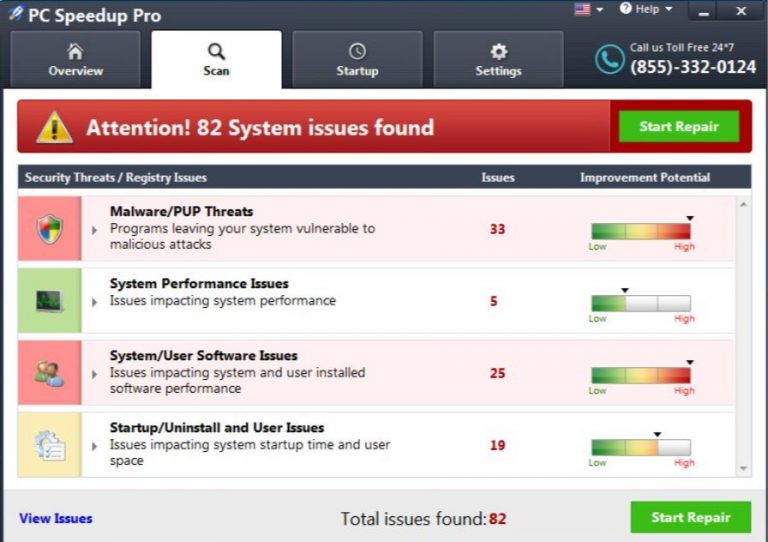PC SpeedUp Pro (Easy Removal Guide)
PC SpeedUp Pro Removal Guide
What is PC SpeedUp Pro?
PC SpeedUp Pro – a potentially unwanted program that displays misleading scan results

PC SpeedUp Pro is a program that claims to be a powerful tool capable of speeding the computer up. Unfortunately, but you may notice a decrease in your computer's speed after installing this application. This effect may be noticed because this program interrupts each computer's tasks with misleading system scans and reports about computer-related issues.
No matter how professionally these reports look, they are displayed just to deceive you into thinking that there's something wrong with your computer and that you need to buy the licensed version of PC Speedup Pro that will fix the imaginary issues.
This marketing scheme has been actively used by PC Fix Speed, PC Mechanic, and other tools that have initiated various discussions on the Internet. If you want to keep your computer in its best shape, you need to stay away from such apps. Also, we would like to recommend you remove this application from the system. You can find all steps for that in this article.
| name | PC SpeedUp Pro |
|---|---|
| Type | Potentially unwanted program |
| Purpose | Sell its paid version by showing fabricated system error reports and stating that a paid version will fix them |
| Risks | Money loss |
| Elimination | You can remove this program either manually or automatically. Both ways are described below |
| System fix | Runs a system tune-up with the [1] tool to repair any damage your device's system may have suffered |
According to cybersecurity experts, PC SpeedUp Pro is a potentially unwanted program (PUP). As we have already mentioned, it will pretend to scan your system, and it will deliver you scan results that will for sure include warnings about errors on your computer.
This program will mostly inform you about fake problems, and then it will urge you to install a full version of it to delete the identified errors. We haven't mentioned that this program may also block Internet access to secure web pages on the Internet to prevent you from downloading legitimate anti-spyware.
In other words, PC SpeedUp Pro tries to frighten you into making an illusion that your computer is working poorly and that you need to fix it as soon as possible. However, it might be just a trick to swindle money from the computer user because we cannot guarantee if this program is capable of fixing any computer errors.
We recommend installing a trustworthy and well-known anti-malware program, for example, SpyHunter 5Combo Cleaner or Malwarebytes. It will detect and eliminate all PUPs and other computer parasites from your system automatically. Then run a scan with the FortectIntego PC repair tool to fix all system-related issues properly.

Methods that are used to distribute the potentially unwanted program
This application has its official web page, and it can be downloaded from it. Unfortunately, our research team claims that this system tool usually travels bundled with freeware or shareware. Therefore, such additional applications almost never inform you about their existence.
To find out if your downloaded program does not have any secret attachments, you have to check the installation settings. Select ''advanced'' or ''custom'' settings, and the configuration window will expand. Now you will be able to see optional downloads if there are any. If needed, untick any unfamiliar suggestions to install apps, plug-ins, add-ons, or extensions.
However, we ask you to be extra careful anytime you install a new program, and especially if it is a free one. You can find a lot of information about the program and its functions in the Terms of Use and Privacy Policy documents. Do not skip them for your own safety.
Tips on how to remove PC Speedup Pro from the system
As we have mentioned, we can hardly believe that this particular tool will be useful for you and your computer. In fact, it may disrupt its functionality by showing questionable warning messages directly on the desktop. Thus, we recommend removing PC Speedup Pro with no delay. If you want to ensure your computer's safety by fixing all system files, use a reliable alternative – FortectIntego.
If you want to get rid of this program, you should know that you can either uninstall PCSpeedUpPro manually or remove this program with the help of reputable anti-spyware software, for example, SpyHunter 5Combo Cleaner or Malwarebytes. If you decide to take on the task manually, please feel free to use our instructions below. Whichever method you prefer, it's recommended to proceed with the removal in Safe Mode with Networking (guide shown below).
Getting rid of PC SpeedUp Pro. Follow these steps
Uninstall from Windows
Instructions for Windows 10/8 machines:
- Enter Control Panel into Windows search box and hit Enter or click on the search result.
- Under Programs, select Uninstall a program.

- From the list, find the entry of the suspicious program.
- Right-click on the application and select Uninstall.
- If User Account Control shows up, click Yes.
- Wait till uninstallation process is complete and click OK.

If you are Windows 7/XP user, proceed with the following instructions:
- Click on Windows Start > Control Panel located on the right pane (if you are Windows XP user, click on Add/Remove Programs).
- In Control Panel, select Programs > Uninstall a program.

- Pick the unwanted application by clicking on it once.
- At the top, click Uninstall/Change.
- In the confirmation prompt, pick Yes.
- Click OK once the removal process is finished.
Manual removal using Safe Mode
Important! →
Manual removal guide might be too complicated for regular computer users. It requires advanced IT knowledge to be performed correctly (if vital system files are removed or damaged, it might result in full Windows compromise), and it also might take hours to complete. Therefore, we highly advise using the automatic method provided above instead.
Step 1. Access Safe Mode with Networking
Manual malware removal should be best performed in the Safe Mode environment.
Windows 7 / Vista / XP
- Click Start > Shutdown > Restart > OK.
- When your computer becomes active, start pressing F8 button (if that does not work, try F2, F12, Del, etc. – it all depends on your motherboard model) multiple times until you see the Advanced Boot Options window.
- Select Safe Mode with Networking from the list.

Windows 10 / Windows 8
- Right-click on Start button and select Settings.

- Scroll down to pick Update & Security.

- On the left side of the window, pick Recovery.
- Now scroll down to find Advanced Startup section.
- Click Restart now.

- Select Troubleshoot.

- Go to Advanced options.

- Select Startup Settings.

- Press Restart.
- Now press 5 or click 5) Enable Safe Mode with Networking.

Step 2. Shut down suspicious processes
Windows Task Manager is a useful tool that shows all the processes running in the background. If malware is running a process, you need to shut it down:
- Press Ctrl + Shift + Esc on your keyboard to open Windows Task Manager.
- Click on More details.

- Scroll down to Background processes section, and look for anything suspicious.
- Right-click and select Open file location.

- Go back to the process, right-click and pick End Task.

- Delete the contents of the malicious folder.
Step 3. Check program Startup
- Press Ctrl + Shift + Esc on your keyboard to open Windows Task Manager.
- Go to Startup tab.
- Right-click on the suspicious program and pick Disable.

Step 4. Delete virus files
Malware-related files can be found in various places within your computer. Here are instructions that could help you find them:
- Type in Disk Cleanup in Windows search and press Enter.

- Select the drive you want to clean (C: is your main drive by default and is likely to be the one that has malicious files in).
- Scroll through the Files to delete list and select the following:
Temporary Internet Files
Downloads
Recycle Bin
Temporary files - Pick Clean up system files.

- You can also look for other malicious files hidden in the following folders (type these entries in Windows Search and press Enter):
%AppData%
%LocalAppData%
%ProgramData%
%WinDir%
After you are finished, reboot the PC in normal mode.
Finally, you should always think about the protection of crypto-ransomwares. In order to protect your computer from PC SpeedUp Pro and other ransomwares, use a reputable anti-spyware, such as FortectIntego, SpyHunter 5Combo Cleaner or Malwarebytes
How to prevent from getting system tools
Stream videos without limitations, no matter where you are
There are multiple parties that could find out almost anything about you by checking your online activity. While this is highly unlikely, advertisers and tech companies are constantly tracking you online. The first step to privacy should be a secure browser that focuses on tracker reduction to a minimum.
Even if you employ a secure browser, you will not be able to access websites that are restricted due to local government laws or other reasons. In other words, you may not be able to stream Disney+ or US-based Netflix in some countries. To bypass these restrictions, you can employ a powerful Private Internet Access VPN, which provides dedicated servers for torrenting and streaming, not slowing you down in the process.
Data backups are important – recover your lost files
Ransomware is one of the biggest threats to personal data. Once it is executed on a machine, it launches a sophisticated encryption algorithm that locks all your files, although it does not destroy them. The most common misconception is that anti-malware software can return files to their previous states. This is not true, however, and data remains locked after the malicious payload is deleted.
While regular data backups are the only secure method to recover your files after a ransomware attack, tools such as Data Recovery Pro can also be effective and restore at least some of your lost data.
